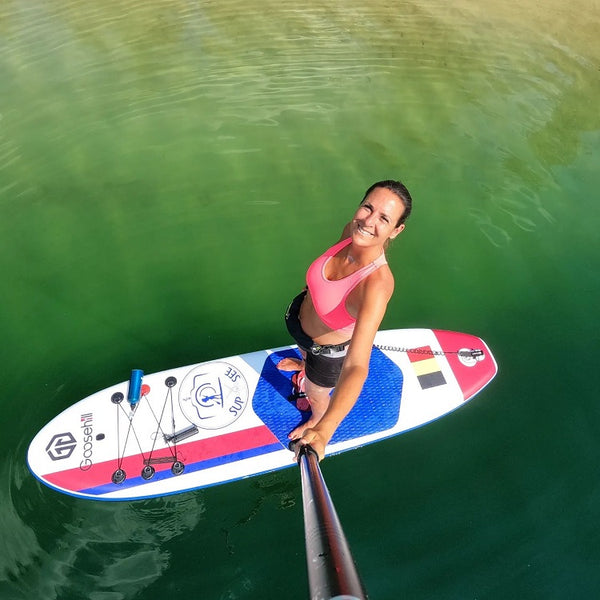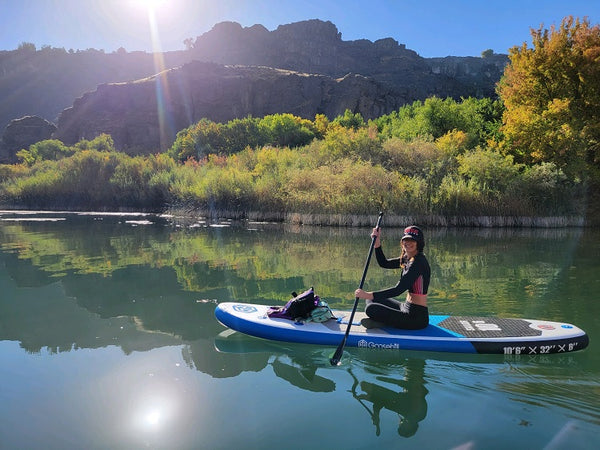Tips To Minimize Body Aches While Paddling

Paddling is a fun and low-impact activity that provides an excellent workout for your arms, legs, core, and back muscles.
Paddlesports are popular recreational activities that offer a chance to explore the outdoors, stay active, and challenge oneself.
For those new to paddling or who have been doing it for a long time, it can cause body aches and discomfort. That's because paddling requires repetitive motions and prolonged periods of sitting in a confined space.
10 Tips To Help You Minimize Body Aches While Paddling
This article will discuss tips to help minimize body aches while paddling, ensuring a more enjoyable and comfortable experience on the water.
1. Getting Equipped for a Comfortable Paddle
Having the right equipment can greatly improve your paddling experience by reducing discomfort and physical strain.
Here are some things to consider:
- Board Selection: Start by choosing a paddle board that is both stable and well-designed. It's essential to select a board that is the right size for you, as an incorrectly sized SUP can make it challenging to maintain proper posture, leading to aches and pains and making paddling more difficult.
- Hybrid Option: If you're unsure whether a paddleboard or kayak is best for you, consider a SUP Kayak Hybrid. These boards offer the best of both worlds, combining the stability of a paddleboard with the comfort of a kayak.
- Paddle Length:Make sure your paddle is the correct length for you. A paddle that is too long or too short can put unnecessary strain on your arms, neck, and back.
By starting with the right equipment, you can make your paddling experience more accessible and comfortable.

2. Warm-Up And Stretching
Warming up and stretching before paddling can help prevent injury and minimize body aches like any physical activity.
Here are some tips for a good warm-up and stretching routine:
- First, start with a light cardiovascular activity, such as jumping jacks or jogging, to get your heart rate up and warm up your muscles.
- Do light stretching exercises to loosen up your muscles, such as neck rolls, arm swings, and torso twists.
- Pay particular attention to stretching your back, neck, arms, and shoulders, as these are the most prone to strain while paddling.
- Finish with a few light paddles to get a feel for the boat and your equipment before starting your paddling session.
3. Proper Posture And Body Mechanics
Maintaining a good posture can help distribute stress evenly throughout the body and prevent excessive strain on any one area.
Keeping your back straight, shoulders relaxed, and elbows close to your body are some ways to maintain proper posture. For your assurance, read some paddle boarding tips to help you paddle like a pro.
4. Take Breaks And Rest
Taking breaks and resting periodically while paddling can help prevent fatigue and minimize body aches.
Here are some tips:
- Take a break every hour or so to stretch and rest your muscles.
- Get out of the boat and stretch your legs, back, and arms.
- Take a drink of water and hydrate to prevent dehydration.
- Avoid staying in the same position for too long, and change positions periodically to distribute the stress evenly throughout the body.
5. Stay Hydrated
Staying hydrated is essential to prevent fatigue and minimize body aches while paddling. Drink plenty of water before, during, and after your paddling session to keep your body hydrated.
6. Use Paddling Gloves
Using paddling gloves can help reduce the strain on your hands and wrists. Look for gloves that provide a good grip and support your hands and wrists.
7. Use A Supportive Back Brace
A supportive back brace can help reduce the strain on your back while paddling. Look for a back brace that provides good support and is comfortable.
8. Strengthen Your Core Muscles
Strengthening your core muscles can help to reduce the strain on your back and neck while paddling. Incorporate exercises such as planks, sit-ups, and back extensions into your fitness routine to strengthen your core.
9. Strengthen Your Upper Body
If you strengthen your upper body, it can help to reduce the strain on your arms and shoulders while paddling. Try exercises such as push-ups, pull-ups, and rowing into your workout to strengthen your upper body.
10. Keep Your Paddleboard Well-Maintained
Keeping your board well-maintained can reduce the physical strain of paddling. Rinse it after each use, store it in a cool, dry place, and protect it from sun damage with silicone spray or UV protectant. Also, check for leaks and wear regularly, and secure it and its paddles.
Types of Paddling Activities
Kayaking, canoeing, and stand-up paddle boarding encompass many experiences. It includes leisurely paddling on lakes and rivers, braving white water canoeing and sea surfing, and participating in sprint races or marathons.
Competition and specialized activities like sea paddle boarding or white water canoeing offer a more demanding experience. Additionally, you also need special equipment, abilities, and knowledge.
You must prepare yourself thoroughly and possess the necessary skills for the type of paddling you have planned.
If you desire to compete or refine your technique, you can learn the basic paddle boarding technique for beginners in no time.

Benefits Of Stand-Up Paddleboarding (SUP)
Excellent full-body workout: SUP is a great way to get a full-body workout, from the toes, which grip the board, to the legs, which maintain balance. It will also assist the core, which controls the arms and back, and fingers, which grip the paddle.
Relieves stress: Even if you are not typically one to seek comfort in the great outdoors, being on the water will have a calming effect on you. There's nothing like a day on the water to help you unwind and forget your worries.
Low-Impact exercises: SUP is an excellent option to give your joints a break from running or other high-impact workouts. As a low-impact alternative to activities like swimming and biking, this is a great way to get in shape.
Helps maintain balance: Standing on a paddle board requires a strong core and legs. Maintaining a low center of gravity and placing your body in the proper position on a paddleboard are the keys to keeping your balance.
You'll quickly learn that balance is essential, as losing your footing will result in an embarrassing plunge into the water.
Cardiovascular exercise: Depending on your SUP session's strenuous, it can serve as a cardiovascular workout. Stand-up paddleboarding (SUP) can be a lot of fun if you throw in a few races to spice things up and get your blood pumping.
Great way to spend time with loved ones: The best way to enjoy paddleboarding is with friends or family, so try organizing an afternoon outing. Seek a nearby shore or small island to which you can paddle for a day of swimming and sunbathing.
You should use a comfortable padding board for SUPing. For instance, Goosehill Inflatable SUP Board is a great option to consider.
Treatment For Injuries While Paddling
If you sustain an injury while paddling, taking proper care of it is essential to avoid further harm.
Here are some tips on what to do in case of an injury:
- First, halt your activity immediately upon sustaining an injury to prevent additional damage.
- Seek medical attention promptly.
- For soft tissue injuries such as muscle strains, ligament sprains, bumps, and bruises, follow the RICE method- rest, ice, compression, and elevation.
- In case of heat stress or sunburn, move to a shaded area, avoid sun exposure, drink more water, and seek medical professionals.
- If you suffer from hypothermia, move to a dry and warm place and gradually warm your body with a thermal blanket and dry clothing. Ensure to drink and eat enough to maintain adequate calorie intake.
- Only resume paddling activities once you completely recover from your injury.

Things To Keep In Mind While Paddling
Here are some essential things to remember while Paddling:
- Wear appropriate personal flotation devices (PFDs) and helmets, if necessary.
- Check the weather and water conditions before embarking on your trip.
- Familiarize yourself with the route and any potential hazards.
- Pack essential supplies, including food, water, a first-aid kit, and a means of communication.
- Follow all boating laws and regulations, including obtaining required permits and licenses.
- Respect other paddlers, wildlife, and the environment.
- Practice safe paddling techniques and be aware of your surroundings at all times.
- Always paddle with a partner or in a group for safety reasons.
- Keep a close eye on the weather and be prepared to act appropriately in changing conditions.
- Know your limits and do not take unnecessary risks. If you encounter any difficulties, seek help immediately.
Conclusion
You now know how to minimize body aches while paddling. You may start by finding a comfortable position to maintain good posture and balance in the boat.
Make sure to stretch before and after paddling to help prevent muscle strain and stiffness. Additionally, investing in a properly fitted paddle and a comfortable seat can help reduce stress on your arms, back, and hips.
By following these tips and listening to your body, you can enjoy a more comfortable and enjoyable paddling experience.
FAQs
- How long does it take to learn SUP?
Paddling for the first time can be intimidating, but most people can learn quickly and paddle around the water paddling within 20 minutes. Because it is easy to understand, this sport is popular with people of all ages and skill levels.
- Can I use a stand-up paddleboard as a kayak?
Yes, you certainly can! Add a SUP kayak seat to your paddle board and get the best of both worlds. After that, you can use the same paddle for your SUP and kayak. You can always go back to using your SUP if you want to.
- Where can I go paddling?
You can paddle in various bodies of water, such as lakes, rivers, oceans, and canals. Before heading out, check the local weather and water conditions, as well as any required permits or safety regulations.










